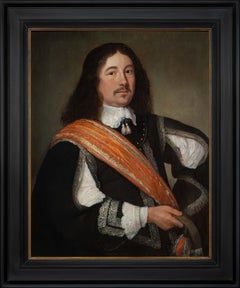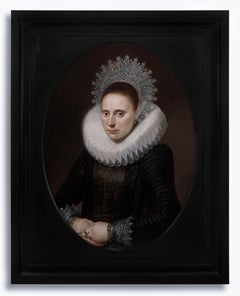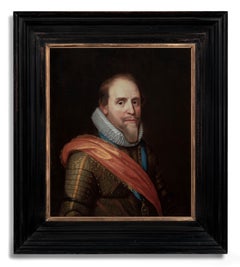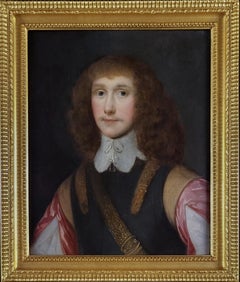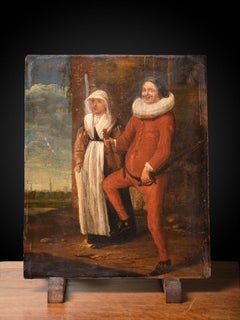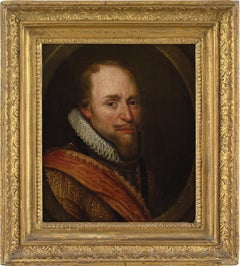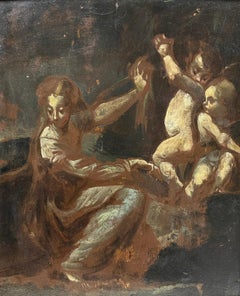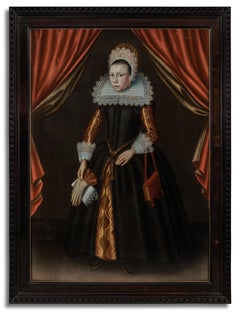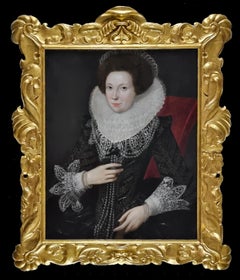Panel More Art
to
7
1
7
1
1
2
1
2
2
Overall Height
to
Overall Width
to
6
8
3
16
533
1
1
2
11,725
61
54
50
41
Period: 18th Century and Earlier
Medium: Panel
Portrait Gentleman Black Coat Orange Sash, Dutch Old Master, Oil on Panel c.1650
By Bartholomeus van der Helst
Located in London, GB
This exquisite portrait of a gentleman depicted in a sumptuous black coat edged with silver and slashed sleeves is an excellent example of the type of portrait fashionable in England and the Low Countries during the 17th century. The confident pose, striking orange sash - the colour of the house of Orange Nassau - and the leather gorget imbue the sitter with a sense of masculinity and power. The profusely decorated costume is of the highest quality and de rigueur of an elite class - the artist has carefully cultivated this portrait to emphasise the sitter’s wealth and standing in the society that he belonged to. The casual pose, with one arm resting on a hip, is much less formal than earlier decades, and it speaks of ‘sprezzatura’ – one’s appearance should not appear laborious, but instead, effortless.
The oil on cradled panel portrait can be dated to circa 1650 based on the hairstyle and the attire - small falling collar, short doublet (doublets reduced in size to just below the ribcage in the late 1650’s), and the type of slashed sleeves with the sleeve seams left open to reveal the white fabric.
The demand for portraits in the Netherlands was great in the 17th century. Bartholemeus van der Helst was considered to be one of the leading portrait painters of the Dutch Golden Age surpassing even Rembrandt as the most sought-after portraitist in Harlaam. The Dutch Golden Age, roughly spanning the 17th century, was a period when Dutch trade, science, military, and art were among the most acclaimed in the world. Dutch explorers charted new territory and settled abroad. Trade by the Dutch East-India Company thrived, and war heroes from the naval battles were decorated and became national heroes. During this time, The Dutch Old Masters began to prevail in the art world, creating a depth of realistic portraits of people and life in the area that has hardly been surpassed. The Golden Age painters depicted the scenes that their discerning new middle-class patrons wanted to see. This new wealth from merchant activities and exploration combined with a lack of church patronage, shifted art subjects away from biblical genres. Still life’s of items of everyday objects, landscapes, and seascapes reflecting the naval and trade power that the Republic enjoyed were popular. The new wealthy class were keen to have their portraits commissioned and many artists worked in this lucrative field. Such was the popularity of art that everyone had a painting, even the humble butcher, and hundreds of thousands of paintings were produced.
By tradition the sitter is Maarten Tromp (1598-1653) who was an Admiral in the Dutch Navy (the reverse of the portrait contains an old handwritten inscription “van Tromp”). Certainly, the distinctive orange sash is similar to those worn by officers of the Dutch army in the Netherlands who served under the Princes of Orange and the House of Nassau. However, it should be noted that the physiognomy differs from other images of Tromp.
Tromp was the oldest son of Harpert Maertensz, a naval officer and captain. He joined the Dutch navy as a lieutenant in July 1622 and was later promoted from captain to Lieutenant-Admiral of Holland and West Frisia in 1637. In 1639, during the Dutch struggle for independence from Spain, Tromp defeated a large Spanish fleet bound for Flanders at the Battle of the Downs, which marked an enormous change - the end of Spanish naval power. He was killed in action during the First Anglo-Dutch War in 1653 where he commanded the Dutch fleet in the battle of Scheveningen.
Gloves were an absolutely vital accessory and the elaborate pair in this portrait are embellished with threads of silk and precious metals and salmon-coloured lining. He wears only one glove and holds the other, providing an opportunity to better display the cuffs and detail on his right wrist and forearm. The gloves are probably made from the most prized leather which came from Spain, in particular from Cordova. Cordovan leather was tanned with a special vegetal process that left it both highly impermeable and divinely soft. King Charles I, posed in a rather relaxed manner for Daniel Mytens’s portrait in 1631, is wearing gloves and boots in matching Cordovan leather. The hide is thick, but you can see just how supple it is from the way the gauntlet dimples and the long boot legs fold over themselves, rippling and wrinkling at the ankles.
Apart from keeping hands warm the use of gloves during the 15th through the 19th centuries were full of symbolism and they were worn regardless of the season. They kept the skin unblemished - soft, smooth hands were considered highly attractive. This combination of necessity and proximity to bare skin made gloves a deeply personal gift and they took on a strong symbolic significance and were regarded as emblematic of fidelity and loyalty for hundreds of years. Such was the importance of their symbolism was that some gloves were never intended to be worn at all. Their luxury made them ideal gifts at court, and so in the 15th and 16th centuries, ambassadors often presented them as symbols of loyalty.
Until the mid-19th century, it was customary to give gloves as tokens to guests at weddings and to mourners at funerals. Gentleman often gifted their bride-to-be with a pair of gloves (the obligatory gift) and were handed over at the betrothal and put on display before the wedding took place. It was probably their direct contact with the skin that led to the eroticism of gloves. Not only were pairs often exchanged between lovers, but from the 16th to the 18th centuries, it was common practice to remove one glove and give it as a gift to a favourite. The idea of the item being presented still warm from the wearer’s hand is certainly suggestive. Following the death of King George IV, his executors purportedly found over a thousand mismatched ladies’ gloves among his possessions.
The sentiment of a 17th-century poem reveals the popularity of the practice: “Come to our wedding to requite your loves / Shew us your hands and we’ll fit you with gloves.” Such generosity might be pricey for the hosts, but gloves of varying quality could be offered depending on the status of the recipient. Pairs made with the finest Spanish leather might be reserved for immediate family, while coarse sheep’s leather could be distributed among the servants and tradesmen. The apportioning of quality according to class provided a very clear message of the gloves’ intended use. For refined guests, they were decoration; for the lower classes, they were functional.
Bartholomeus van der Helst...
Category
17th Century Old Masters Panel More Art
Materials
Oil, Wood Panel
Portrait of a Lady in an Elaborate Ruff & Lace Coif c.1610-20, Dutch Old Master
Located in London, GB
This magnificent oil on panel portrait, presented by Titan Fine Art, is a splendid example of the sumptuous female portraits that were painted for members of the upper echelons of society during the early part of the 1600’s. The artist has rendered this portrait with meticulous attention to detail and the surface effects of the fine materials. The elaborate lace coif and cuffs are painstakingly delineated, as is the bold black damask, and sumptuous gold decoration of her skirt and stomacher, which is wonderfully preserved and quite remarkable considering the age of the work and the fact that darker pigments are particularly vulnerable to fading and wear. This work with its spectacular depiction of costume is of absolute quality, it can be rated as one of the best works in the artist’s oeuvre and as such it is an important and splendid example of Dutch portraiture.
The Dutch Golden Age of painting was a period in Dutch history, roughly spanning the 17th century, in which Dutch trade, science, military, and art were among the most acclaimed in the world. Dutch explorers charted new territory and settled abroad. Trade by the Dutch East-India Company thrived, and war heroes from the naval battles were decorated and became national heroes. During this time, The Dutch Old Masters began to prevail in the art world, creating a depth of realistic portraits of people and life in the area that has hardly been surpassed. The Golden Age painters depicted the scenes that their discerning new middleclass patrons wanted to see. This new wealth from merchant activities and exploration combined with a lack of church patronage, shifted art subjects away from biblical genres.
Dress was a key component in portraits, and the exuberant attire reiterates the incredible wealth of this woman. The sitter will have visited the artist’s workshop and inspected examples on display. They would have chosen the size and the sort of composition and on that basis negotiated the price – which would have also been determined by the complexity of the clothing and the jewels that were to be depicted, and by the materials to be used. When all was considered, this portrait would have cost the sitter (or her husband) a substantial sum.
The colour black was regarded as humble and devout yet at the same time refined and sophisticated and the most expensive colour of fabric to dye and to maintain. Citizens spent fortunes on beautiful black robes. Such uniformity must also have had a psychological side-effect and contributed to a sense of middle-class cohesion; the collective black of the well-to-do burgess class will have given its members a sense of solidarity. The colour was always an exciting one for artists and when this portrait was painted there were at least fifty shades of it, and as many different fabrics and accoutrements. Artists went to great lengths to depict the subtle nuances of the colour and the fabrics and textures and how they reflected light and it was an ideal background against which gold and crisp white lace could be juxtaposed to dramatic effect.
The sitter is either a married women or a widower as is evident by the clothing that she wears and the position, toward her right, it is highly likely that this portrait was once a pendant that hung on the right-hand side of her husband’s portrait as was convention at the time. She wears a vlieger which was a type of sleeveless over-gown or cape worn by well-to-do married women in the late 16th and early 17th centuries. Variations with short sleeves or high shoulder rolls are known. Sometimes sleeves were attached with aiglets, and often slits were made to allow belts or the hands to pass through. Three-piece vlieger costumes of this kind were standard items of clothing in portraits of the women of the civic elite in the period 1600-40 and was a variant of the Spanish ‘ropa’ and served as a trademark of well-to-do married burgher women. Girls and unmarried woman, including beguines, wore a bouwen (a dress with a fitted bodice and a skirt that was closed all round) instead. This clear distinction between apparel for married and unmarried women is clear not only from inventories and trousseau lists, but also from contemporary sources such as the Dutch Spanish dictionary published by Juan Rodrigues in 1634. In it, a bouwen is described as a ‘ropa de donzella’ (over-gown worn by a virgin) and a vlieger as a ‘ropa de casada’ (overgown worn by a married woman). It is striking how few women are depicted wearing a bouwen, unless they are part of a group, family or children’s portrait and it can therefore be assumed that independent portraits of unmarried women were seldom commissioned. It is also believed that the clothing worn in these portraits existed and were faithfully reproduced when cross-referenced with the few exact documents. These sources also demonstrate that clients wanted their clothing to be depicted accurately and with this in mind precious garments and jewels were often left in the painter’s studio.
The prominent white lawn molensteenkraag (or millstone ruff) is held up by a wire supportasse and was reserved only for the citizens that could afford this luxurious item that often required 15 meters of linen batiste. The fabulous wealth of this sitter is also evident by the elaborate lace coif and cuffs which have been exquisitely depicted; lace was often literally copied by artists in thin white lines over the completed clothing.
The gold bracelet with jewels is a type that was evidently fashionable as it is seen in a number of portraits during the 1610s and 1620. Clothing and jewellery were prized possessions and were often listed in inventories of estates and passed down from generation to generation. There were a great number of jewellers of Flemish origin working at all the courts and cities of Europe, competing with the Italians, and then the French, adapting themselves to the tastes and positions of their patrons and the raw materials available in the country where they worked. The fashion for jewels “in the Flemish style” succeeded that of the Italian style.
Cornelis van der Voort, who was probably born in Antwerp around 1576, came to Amsterdam with his parents as a child. His father, a cloth weaver by trade, received his citizenship in 1592. It is not known who taught the young Van der Voort to paint, but it has been suggested that it was either Aert Pietersz or Cornelis Ketel. On 24 October 1598 Van der Voort became betrothed to Truytgen Willemsdr. After his first wife’s death he became betrothed to Cornelia Brouwer of Dordrecht in 1613. In addition to being an artist, Van der Voort was an art collector or dealer, or both. In 1607 he bought paintings from the estate of Gillis van Coninxloo, and after an earlier sale in 1610 a large number of works he owned were auctioned on 7 April 1614. Van der Voort is documented as appraising paintings in 1612, 1620 and 1624. In 1615 and 1619 he was warden of the Guild of St Luke. He was buried in Amsterdam’s Zuiderkerk on 2 November 1624, and on 13 May 1625 paintings in his estate were sold at auction.
Van der Voort was one of Amsterdam’s leading portrait painters in the first quarter of the 17th century. Several of his group portraits are known. It is believed that he trained Thomas de Keyser (1596/97-1667) and Nicolaes Eliasz Pickenoy (1588-1650/56). His documented pupils were David Bailly (c. 1584/86-1657), Louis du Pré...
Category
17th Century Old Masters Panel More Art
Materials
Oil, Wood Panel
Dutch Old Master Portrait of Maurits, Prince of Orange-Nassau, Oil on Panel
Located in London, GB
In 1607, the Delft city council decided to commission a portrait of Stadholder Maurits of Nassau for the town hall, with Michiel van Mierevelt as the chosen artist due to the passing...
Category
17th Century Old Masters Panel More Art
Materials
Oil, Wood Panel
Portrait of Gentleman, Thomas Bruce, Earl of Elgin c.1638 Manor House Provenance
Located in London, GB
Titan Fine Art present this picture which formed part of a historic collection of an English aristocratic family, Lord and Lady Sandys at their magnificent baroque and Regency Grade-...
Category
17th Century Old Masters Panel More Art
Materials
Oil, Wood Panel
Portrait of a Lady Diana Cecil, Countess of Elgin c.1638, Manor House Provenance
Located in London, GB
Titan Fine Art present this picture which formed part of a historic collection of an English aristocratic family, Lord and Lady Sandys at their magnificent baroque and Regency Grade-...
Category
17th Century Old Masters Panel More Art
Materials
Oil, Wood Panel
17th C painting of a peasant couple preparing for Carnival.Flemish School.
Located in brussel, BE
Preparation for Carnival: a three day festival of insatiable eating, drinking and carousing that preceded the forty days of Lent, a period of penitence when the pious drank only wate...
Category
17th Century Baroque Panel More Art
Materials
Oil, Wood Panel
Dutch or Flemish Landscape with Figures & Animals
Located in Milford, NH
A beautifully detailed late 17th or early 18th century Dutch or Flemish landscape with cows grazing in the water, goats, dogs, and other animals near the water’s edge, under the watchful eye of the herdsmen, on a backdrop of rolling hills and trees. Oil on wood panel, unsigned, and housed in a Rudolph...
Category
Late 17th Century Flemish School Panel More Art
Materials
Oil, Wood Panel
Dutch Old Master Portrait of Girl aged 9 in Black Dress & Lace Ruff dated 1619
Located in London, GB
Portrait of a Noble Young Girl, aged 9, in a black dress with lace ruff and cuffs, Dated 1619
Circle of Cornelis van der Voort (1576- 1624)
Oil on cradled panel
Presented by Titan ...
Category
17th Century Old Masters Panel More Art
Materials
Oil, Wood Panel
Related Items
Michiel Jansz. Van Mierevelt (Follower), Portrait of Maurice of Orange
Located in Cheltenham, GB
This early to mid-17th-century oil on panel depicts Maurice of Nassau (1567-1625), Prince of Orange. It’s a bust-length portrait, presented in a feigned oval, after a full length by ...
Category
Mid-17th Century Old Masters Panel More Art
Materials
Oil, Wood Panel
Angelic Cherubs with Classical Figure in Wilderness Finely Painted Preparatory
Located in Cirencester, Gloucestershire
Figure with Cherubim in Wilderness
Italian School, 17th century
oil painting on wood panel
framed 13 x 11 inches
condition: overall for its age very good, though the work is most likely a preparatory...
Category
17th Century Old Masters Panel More Art
Materials
Wood Panel, Oil
Oil Portrait of a Victorian Lady, c. 1850
Located in Chicago, IL
Painted in the 19th century, this exquisite miniature portrait wonderfully exemplifies realism in traditional oil painting. The small artwork is painted in the conventional portraiture style of the Old Masters, and achieves soft realism with fine brushwork and a subdued, neutral palette. The half length portrait depicts a fine Victorian woman dressed in all black with a delicate lace collar and bonnet. She wears a ruby broach...
Category
Mid-19th Century Old Masters Panel More Art
Materials
Oil
Man in Tavern Smoking a Pipe /// Old Masters Dutch David Teniers Portrait Face
Located in Saint Augustine, FL
Artist: Unknown (Circle of David Teniers the Younger, Flemish, 1610-1690)
Title: "Man in Tavern Smoking a Pipe"
*No signature found
Circa: 1690
Medium: Original Oil Painting on Wooden Board
Framing: Framed in an antique gold gesso frame...
Category
1690s Old Masters Panel More Art
Materials
Gold Leaf
The Card Players by a Flemish 1600s Artist
Located in Stockholm, SE
Flemish 1600s School
The Card Players
oil on oak panel
panel dimensions 22.5 x 20 cm
frame included
Provenance:
From a Swedish private collection.
Condition:
Flat and stabl...
Category
17th Century Old Masters Panel More Art
Materials
Oak, Oil, Panel
Portrait Of A Young Woman
By Adriano Goby
Located in San Francisco, CA
Adriano Goby 19th century oil portrait of a beautiful young lady, circa 1890s
Superb antique oil portrait, possibly, French. The painting is signed in the upper left corner (see pic...
Category
Late 19th Century Impressionist Panel More Art
Materials
Oil
17th C, Baroque, Flemish School, Saint Francis in Ecstasy.Oil on oak panel.
Located in brussel, BE
During the Counter-Reformation, the traditional cult of saints was encouraged, and spiritual exercises were recommended to come closer to God. In the pai...
Category
17th Century Baroque Panel More Art
Materials
Oil
H 37.8 in W 49.02 in D 2.37 in
"Caterina d'Alexandria (Saint Catherine of Alexandria)" classical religious
By (After) Giampietrino
Located in Milwaukee, WI
"Caterina d'Alexandria (Saint Catherine of Alexandria)" is an original oil painting on wood panel, likely painted by Italian artist Giampietrino (Giovanni Pietro Rizzoli). The painti...
Category
19th Century Old Masters Panel More Art
Materials
Oil, Wood Panel
18th century portrait of the painter Nathaniel Dance
Located in London, GB
Collections:
Robert Gallon (1845-1925);
Private Collection, UK.
Oil on canvas laid down on panel
Framed dimensions: 11.5 x 10 inches
This highly engaging, previously unpublished portrait by Johan...
Category
18th Century Old Masters Panel More Art
Materials
Oil, Wood Panel, Canvas
The Veronica of the Virgin (Verónica de la Virgen)
Located in New York, NY
The panel has been attributed both to Joan de Joanes and his son Vicente Macip Comes (Valencia, ca. 1555 – 1623).
Provenance:
Private Collection, England, by 1886 (according to stencils on the reverse)
Private Collection, New Jersey, until 2010
The Veil of Veronica, often called the Sudarium, is one of the most important and well-known relics of Christ. According to legend, Veronica offered Christ her veil as he carried the cross to his crucifixion. He wiped his face with the veil, which left the cloth miraculously imprinted with his image. Depictions of Christ’s face on a veil, or simply images that focused in on Christ’s face, were treasured objects of religious devotion. The popularity of this format also inspired similar images of the face of the Virgin.
The iconographic type of the present painting is known as the Veronica of the Virgin, which was especially favored in late medieval and early Renaissance Spain. Distinct from the images of the suffering Christ, the Veronica of the Virgin is based on the legend that Saint Luke painted a portrait of Mary from life. Although scholars have sometimes mistaken them for portraits of Queen Isabella I of Castile (known as Isabel la Católica) or as a depiction of Saint Maria Toribia (known as María de la Cabeza, or, Mary of the Head), paintings like this one were clearly intended as images of the Virgin in the style of Saint Luke’s lost portrait.
The Veronica of the Virgin was especially popular in Valencia, and depictions of this subject produced there all stem back to one visual prototype: a Byzantine image in the city’s cathedral (Fig. 1). This early treatment of the Veronica was given to the cathedral in 1437 by Martin the Humane, King of Aragon and Valencia, who promoted religious veneration of the Veronica of the Virgin as part of the celebration of the Immaculate Conception of Mary. This devotion spread throughout Martin’s kingdom and particularly took hold in Valencia, where the Byzantine image resided. The image, which is displayed in a gold reliquary...
Category
16th Century Old Masters Panel More Art
Materials
Oil, Wood Panel
Italian Greyhound and Friends - Italian 17thC Old Master dog art oil painting
By Francesco Fieravino
Located in London, GB
This stunning Old Master 17th century oil portrait painting is attributed to Francesco Fieravino, an artist famous in his day for still lifes and carpets. This painting which dates t...
Category
17th Century Old Masters Panel More Art
Materials
Canvas, Oil
Large 17th Century Dutch Old Master Oil Painting on Wood Panel Biblical Scene
Located in Cirencester, Gloucestershire
Biblical Figures, Large Gathering around Christ?
Dutch Old Master, early 17th century
oil painting on wood panel, stuck on velvet backing board
velvet board: 27 x 29 inches
board: 25.5 x 26 inches
provenance: private collection, France
condition: good and sound condition, obvious old panel...
Category
Early 17th Century Old Masters Panel More Art
Materials
Wood Panel, Oil
Previously Available Items
Dutch Old Master Portrait of Girl aged 9 in Black Dress & Lace Ruff dated 1619
Located in London, GB
Portrait of a Noble Young Girl, aged 9, in a black dress with lace ruff and cuffs, Dated 1619
Circle of Cornelis van der Voort (1576- 1624)
Oil on cradled panel
Presented by Titan ...
Category
17th Century Old Masters Panel More Art
Materials
Oil, Wood Panel
H 57.49 in W 42.92 in D 2.76 in
Portrait of a Lady in Elaborate Costume with Ruff & Pearls c.1615; oil on panel
By Robert Peake the Elder
Located in London, GB
This exquisite, and important, stately portrait, presented by Titan Fine Art, is a particularly splendid example of the sumptuous female portraits that were painted for members of the court and gentry during the early part of the 1600’s. Dress was a key component in portraits, and the exuberant attire and extravagance of jewellery in this painting reiterates the incredible wealth of this Jacobean woman. The pearl coronet on her head is in the style typically only worn by a Duchess of the realm, further signifying her elevated status.
The satin dress is decorated with myriad of fine white lace and embroidered with gold on the bodice and sleeves. The colour black, the most expensive colour of fabric to dye and to maintain, is juxtaposed against white. This striking combination was a favourite of Elizabeth I and courtiers in homage to the queen, just a few years earlier. There is an abundance of pearls, worn on both wrists, and as a heavy double rope around her neck and linked by a black rosette at her breast. Beneath her lavishly decorated dress is a petticoat called a wheel farthingale, an undergarment that flattened the abdomen and tilted the dress up at the back. The style was brought from Spain—possibly by Catherine of Aragon...
Category
17th Century Old Masters Panel More Art
Materials
Oil, Wood Panel
H 40.95 in W 35.04 in D 3.15 in
Elizabethan Portrait of Thomas Vavasour in a Black Doublet c.1587, Oil on panel
Located in London, GB
This exquisite portrait, presented by Titan Fine Art, was painted during the last quarter of the 16th century – the Elizabethan era – the golden age in English History when Queen Elizabeth I was on the throne. It is a splendid survival from circa 1587, a time that is sandwiched between two golden ages of English renaissance culture, the reigns of Henry VIII and Charles I. This period produced a style of painting quite unlike that anywhere else in Europe and one that deserves serious assessment.
The motivation for portraiture during this period was not aesthetic, but rather dynastic - a means to record ancestors. For most individuals the idea of a painting as a work of art perhaps never existed; it was primarily an expression of rank and class. There is not a huge milieu of works remaining from this age and it must also be noted that of the two percent of the population that made up the gentry classes, many would have owned no portraits at all.
Just a couple of years after our portrait was painted, from about 1590, English painting developed on another course, driven mainly by the artists Marcus Gheeraerts the Younger and Isaac Oliver; they depicted a new mood that was pervading Elizabethan and Jacobean society, which was that of romantic melancholy. Elizabethan painting came to an end when Henry, Prince of Wales, sought a complete change of style of his father’s court. In 1610 and 1612 he gathered the talent needed to do just that and invited the Dutch painter Miereveldt, who was seen as the perfect proponent for an updated style, to England.
The portrait is emblazoned with the coat of arms of the Vavasour family - great landowners in Yorkshire and Lincolnshire for centuries; their history dates to Norman times. They are featured on the Battle Abbey Roll and their main seat was Hazlewood Castle, near Tadcaster, from the time of the Domesday Book until 1908. The Vavasours are of Anglo-Norman descent and the various branches of the family are said to have descended from William le Vavasour. During the years between the English Reformation up until the Catholic Emancipation, the Vavasours were noted as a recusant family for remaining staunchly Catholic despite being fined numerous times. By showing up at services several times a year and pretending to conform to Anglicanism, they largely escaped persecution and managed to retain their property and wealth.
The sitter is probably Sir Thomas Vavasour (1560-1620) who was a member of Elizabethan Parliaments. Sir Thomas was the oldest son of Henry Vavasour of Copmanthorpe, Yorks. and Margaret Knyvet. He married Mary Dodge and the couple had four sons and two daughters. His sister, Anne, was Gentlewoman of the Bedchamber about 1580. In 1585 he went over to the Netherlands as Captain of Foot from Yorkshire, retaining this command until 1591, distinguishing himself in an attack on a sconce near Arnhem in Oct 1585, and again two years later. His service in the Netherlands also advanced Vavasour at home. He is thought to have been knighted before August 1595.
Following military service, he was a Gentleman Pensioner until the death of Queen Elizabeth at Richmond Palace...
Category
18th Century Old Masters Panel More Art
Materials
Oil, Wood Panel
H 26.78 in W 20.48 in D 1.97 in
Portrait of Heinrich Mühlegg, Monogrammed & dated 1600, Oil on panel, Gentleman
Located in London, GB
Portrait of Heinrich Mühlegg, the younger (c.1575-1654), Monogrammed and dated 1600
By Lorenz Strauch (1554-c.1630)
This magnificent oil on panel portrait, presented by Titan Fine A...
Category
17th Century Old Masters Panel More Art
Materials
Oil, Panel, Wood Panel
H 31.11 in W 25.79 in D 1.58 in
Fine Portrait of Gentleman in Blue Coat & Powdered Wig c.1775, Rare Oil on Panel
Located in London, GB
A superb and rare example of the artist’s work.
Titan Fine Art present this portrait, a fine example of the late 18th century English school, where the sitter is portrayed in a standard gentlemanly manner. Depicted in a blue coat with large gold buttons, white cravat, and a fashionable powdered wig...
Category
18th Century Old Masters Panel More Art
Materials
Oil, Panel, Wood Panel
Henry WaltonFine Portrait of Gentleman in Blue Coat & Powdered Wig c.1775, Rare Oil on Panel, c.1775
H 13 in W 11.03 in D 1.38 in
Pair 18th Century Paintings Angels on Wood Panels Naive French Provincial Church
Located in FR
Two Antique Paintings Angels all Original Epoque on 18th Century Wood Panels Ecclesiastic
French provincial
Naive primitive and absolutely charming
Decorative and full of character
P...
Category
Late 18th Century Other Art Style Panel More Art
Materials
Oil, Wood Panel
H 21.86 in W 10.24 in D 0.6 in
Panel more art for sale on 1stDibs.
Find a wide variety of authentic Panel more art available on 1stDibs. While artists have worked in this medium across a range of time periods, art made with this material during the 21st Century is especially popular. If you’re looking to add more art created with this material to introduce a provocative pop of color and texture to an otherwise neutral space in your home, the works available on 1stDibs include elements of blue, pink, purple, orange and other colors. There are many well-known artists whose body of work includes ceramic sculptures. Popular artists on 1stDibs associated with pieces like this include Stefan Traloc, Justin Wheatley, Mauro Oliveira, and Carlton Scott Sturgill. Frequently made by artists working in the Contemporary, Abstract, all of these pieces for sale are unique and many will draw the attention of guests in your home. Not every interior allows for large Panel more art, so small editions measuring 0.1 inches across are also available Prices for more art made by famous or emerging artists can differ depending on medium, time period and other attributes. On 1stDibs, the price for these items starts at $1 and tops out at $929,058, while the average work can sell for $1,104.
Recently Viewed
View AllMore Ways To Browse
Twelve Twenty
Chinese Gouache
Large Yellow Mid Century Painting
Two Cardinales
Old Master Drawing Head
Cubist Poster
Hunt Slonem Large Paintings
Japanese Bow
Japanese Fish Painting
Painting Japan Fish
Dior Summer Dress
Union Jack Art
Large Vintage Advertising Signs
Child And Dog
French Comics
Painting Of A Desk
Animal Trade Signs
Portland Glass
